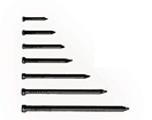Nail and Screw Sizing
What You’ll Need
The following nail and screw fact sheet will help you pick what size screw and nail to use for fastening jobs. Although there is seemingly nothing complicated about a nail or a screw, many are misused due to improper sizing. Therefore, determining the right nail and screw sizes is essential for the success of your project.
Selecting the Proper Nail and Using it Correctly
Although there are many different types of nails and brads, four types will handle most fastening jobs.
The common nail is most widely used. It has a flat head and is used where the appearance of the nail head is not objectionable. The length of a common nail is identified by its “penny” size. In the early days of nail manufacturing, this term designated the weight of nails per hundred. Today it designates only the length and size of the nail. The designation 2d, 3d, 4d, etc., identifies a 2-penny, 3-penny, 4-penny nail, etc.

The casing nail is used primarily on cabinet work or interior trim. Casing nails are slightly heavier than finish nails. The heads of casing nails are normally countersunk and covered with putty or wood filler to hide them from view.

Finishing nails have rounded heads that can be driven flush with the surface of the wood. Although they are often countersunk like casing nails, they can be used without countersinking.

Common brads are designated by length only. Brads are recommended for light assembly work where the head should be concealed. They are thinner, shorter, and smaller than finish nails.

Use the nail selection chart below for selecting the proper nail or brad for various thicknesses of wood. The chart shows the recommended type and size of nail or brad for woods of various thicknesses. You may want to make some variations from the chart, but it can be a practical guide in nail selection.

About the author